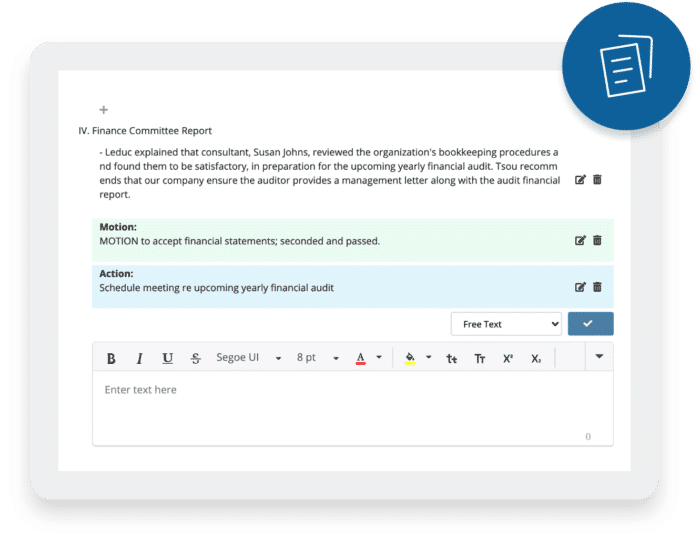One sure way to improve the efficiency of your board is to take better minutes. What makes minutes good? We hear from directors that good minutes are short, easy to scan and refer back to.
Taking clear and concise meeting notes is crucial for compliance purposes and also for your board members’ future reference. After all, board meeting minutes don’t just summarize meetings – they are a written record that also provides meeting attendees with an understanding of actions to be taken as a result.
But if you’re new to your role as a minutes taker or want to improve your meeting minutes’ effectiveness, it can be hard to know where to begin. That’s why we’ve put together this comprehensive guide to help you understand why minute-taking is so important and how to produce clear, concise and valuable meeting minutes. You may also want to consider using meeting minutes software to really boost your effectiveness.
You can also skip ahead to specific sections:
- Importance of board meeting minutes: legal and compliance requirements
- Types of board meeting minutes: open and closed sessions
- How to take minutes at board meeting in 10 steps
- Reviewing and amending board meeting minutes: revision guidelines
- Board meeting minutes template
- Sample board meeting minutes
- 6 bonus tips for more effective board minutes
Importance of board meeting minutes: legal and compliance requirements
Why are board meeting minutes so important? Minutes serve as an official record of the discussions, deliberations, and decisions made during board meetings. They provide a historical account of important matters, ensuring transparency and accountability, and provide a means of communication between board members and stakeholders who were not present at the meeting.
Additionally, meeting minutes also demonstrate that the board is fulfilling its legal and fiduciary requirements. For example, corporate laws may require that minutes be kept and maintained as part of corporate governance practices. Nonprofit organizations may also be subject to specific regulations that require board meeting minutes to demonstrate compliance with laws related to nonprofit operations, fundraising, tax-exempt status, or governance.
Boards must also adhere to their own bylaws, articles of incorporation, or other governance documents. These documents often outline the requirements for board meetings and minutes, including what should be recorded, how minutes should be approved, and how they should be maintained. Board meeting minutes may also be used in legal proceedings or audits to provide evidence of discussions, decisions, and actions taken by the board.
Types of board meeting minutes: open and closed sessions
When it comes to board meeting minutes, there are two types of sessions that can be documented: open sessions and closed sessions.
Open session minutes are the formal record of discussions and decisions made during a board meeting that is open to the public, stakeholders, or members of the organization.
In contrast, closed session minutes are discussions that take place during private or confidential portions of the board meeting including in-camera sessions. These sessions are typically limited to specific topics such as legal issues, sensitive financial information, personnel matters, or discussions related to proprietary information. Due to the sensitive nature of these discussions, access to closed session minutes may be limited to authorized individuals, such as board members, legal counsel, or designated staff members.
Board meeting minutes – 10 simple steps on how to take minutes at a board meeting
Board meeting minutes – before the board meeting
1. Understand your role & your board’s policies
Before beginning, you should have a clear understanding of the expectations of your role as meeting minute taker. Review Robert’s Rules of Order and your board’s specific policies, then clarify anything that you’re unsure about with your board chair or manager. Afterall, writing meeting minutes is important task as it’s the official record of key board activities and decisions.
2. Prepare your minutes template in advance
Preparing a template in advance can help you to stay organized while taking minutes during a board meeting. It can make meeting notes much easier and will help you save time by knowing what sections and information will need to be completed. Using a consistent format also allows a stand-in to follow the same effective template for familiar minutes every meeting.
To prepare your template, obtain the board meeting agenda, if possible. Then, start to build out the following sections with the information you have:
- Type of meeting, such as regular or special
- Date and time of the meeting
- Location of the meeting
- Name of the board chair and secretary
- Names of expected attendees, including speakers and guests
- Overview of the previous board meeting minutes and outcomes
- All agenda items
- Planned hour of adjournment
- Any planned executive/in camera sessions
If there are any supplemental materials, such as reports or handouts included with the agenda, note them in the appropriate sections as well as if they was an amendment to previous meeting minutes.
Need a template to start? Download the Aprio board meeting minute template here.
3. Bring the materials you need to the board meeting
Some board secretaries prefer to use a laptop to take meeting minutes, while others prefer old-fashioned pen and paper. Whatever your preference, ensure that you pack and prepare the necessities you’ll need, including notebook, power cord, pen, etc. You might also want to ensure that you have a backup method for taking minutes in case your first option fails.

Board meeting minutes – during the board meeting
4. Note board meeting attendance
Depending on your board’s preference, take attendance immediately before the board meeting begins or at the very beginning. Some common methods for taking attendance include crossing off names on your board meeting minutes template or circulating a sign-in sheet.
Make sure to note any directors who arrive late. It’s important to have an accurate count of who attended and who was unable to attend, especially if tracking who was and wasn’t present for each motion.
5. Fill in your template as the board meeting progresses
As the board meeting progresses, fill in your board meeting minutes template. You may choose to organize your notes by writing down the number of the agenda item that each minute corresponds to. This will make it easier for you to prepare your finalized meeting minutes document after the meeting.
For each agenda item requiring a decision, be sure to note:
- The actions taken and at what time
- The exact wording of the motions taken, the outcome, and the person who made the motion
- The directors who voted for, against, or abstained on each of the motions
- Any conflicts of interest and how they were handled
Be sure to also record whether the previous meetings’ minutes were approved, the points of order and appeals, any new business, and any executive sessions. Note that meeting minutes are not taken during executive sessions, but it’s important to have a record of their occurrence.
Let your template guide your minutes, and as you write, try to focus on the critical points while being as objective and clear as possible. It’s helpful to focus on themes and outcomes rather than trying to record discussions verbatim. Know that it’s perfectly acceptable to write “a discussion of the options ensued.” If you need clarification on anything, be sure to ask.
6. Record the time the meeting was adjourned
Once the meeting finishes, be sure to capture the hour of adjournment. If the date and time of the next meeting has been decided, note that too.
7. Obtain copies of all reports
If there were new reports presented during the meeting or if you are missing any reports, talk to the person who presented them to ensure you receive a copy before the meeting ends.

Board meetings minutes – after the board meeting
8. Transcribe board meeting minutes
Try to write the “good” copy of your board meeting minutes as soon as you can after the meeting finishes, when the details are still fresh in your mind. Document your meeting minutes in either Google Docs or Microsoft Word format, whichever your organization prefers to use.
Take the time to carefully review the minutes you’ve recorded, and if needed, add additional notes for clarity. Ensure that each action taken by the board includes a brief explanation and rationale for the decision, and if you’re unsure of anything, ask the board chair.
It’s important to help enforce organizational and director accountability. At the bottom of the meeting minutes, make note of the commitments to actions made by the leadership team and directors so that the board chair can hold them accountable.
Finally, be sure to attach any additional documents or reports with the minutes as an appendix, or at least explain where they can be found.
9. Distribute meeting minutes
Board meeting minutes should be prepared and distributed in a timely manner after each board meeting. Ideally, minutes should be circulated to board members for review and approval within a reasonable timeframe, such as before the next scheduled meeting.
Some boards choose to distribute their finalized board meeting minutes via email or hard copy. However, it’s most secure to use board portal software. Board portals also allow you to securely link to supplemental documents from within your minutes and the board of directors can directly add their comments for discussion if needed. Plus, board meeting minute software like Aprio offers granular user permission access such as meeting minutes for closed sessions.
10. Store minutes for future reference
Board meeting minutes should always be stored somewhere secure and accessible for future reference as they are the official record of a meeting and are needed to demonstrate the board’s legal and compliance requirements.
Many boards choose to store their team meeting minutes online, but just be sure that the method you choose is secure, password protected, and only available to authorized board members. Many board meeting minute software options allow you to limit access to authorized individuals only to make it easy to comply with privacy laws and board governance policies.
In addition, be sure to store any additional documents with your finalized minutes for your board’s future reference and for board members unable to attend the meeting.

See this related post: How do you write a board of directors resolution?
Reviewing and amending board meeting minutes: revision guidelines
To ensure board meeting minutes are accurate, complete and clear, reviewing your meeting minutes before distribution is important. Amendments to meeting minutes may also be requested by board members.
Here are some things to double-check when reviewing the board meeting minutes:
1. Is the information accurate and correct?
Carefully read through the minutes to verify that the information accurately reflects what transpired during the meeting. Check for any factual errors, misspellings, or incorrect names, dates, or figures. Cross-reference the minutes with any supporting documents, such as reports or presentations, to ensure accuracy.
2. Is the meeting minutes complete?
Are all important discussions, decisions, and actions captured in the minutes? Review if all key points raised by board members and any significant deliberations are included. Check for the agreed-upon action items and follow-up tasks and confirm that they are accurately documented.
3. Are the minutes objective?
The minutes should maintain an objective tone, presenting a factual account of the meeting. Check for any personal or subjective opinions or interpretations. The minutes should reflect the views and positions of different board members both fairly and impartially.
4. Are the minutes clear and easy to read?
Review the language and structure of the minutes to enhance clarity and readability. Check that your sentences are clear and concise. Use bullet points or subheadings to organize discussions and decisions, making it easier for readers to follow the flow of the meeting.
Guidelines for meeting minute amendments
If any edits are needed for board meeting minutes, it’s important to first document the revisions clearly. Include the date, the name of the person making the revisions, and a brief note explaining the reason for the amendment. This helps maintain an audit trail and ensures transparency in the process.
After making the necessary revisions, you’ll then need to circulate the revised minutes to the board of directors for review and final approval. They should have an opportunity to provide feedback or suggest further changes. Once consensus is reached, the minutes can be officially approved by the board or the designated board chair.
The specific process and guidelines for reviewing and amending board meeting minutes may vary depending on the organization’s bylaws, governance policies, or specific requirements. It’s essential to adhere to any established procedures and seek guidance from the board chair or governance committee if needed.
Want more insights into board best practices? Subscribe to receive monthly news from Aprio.
By providing your email, you consent to receive communications from Aprio. You can unsubscribe at any time. See our Privacy Policy.
Board meeting minutes template
Ensure these key elements are included in your board meeting minute template:
- Date, time, location
- Type of board meeting — regular, special or annual
- Attendance of board chair, board members, secretary and other guests
- If quorum requirements are satisfied
- Approval of previous meeting minutes
- Reports and presentations including names and titles of presenter
- Action steps required
- Attachments of presentations or documents circulated
- Closing summary that includes a timestamp of adjournment, the next meeting date and time, and approval signature the relevant authority such as the president or CEO
You may need to tailor your meeting minute template to the specific needs and requirements of your organization. Consider incorporating any additional sections or information necessary to comply with legal and governance obligations or to capture specific elements relevant to your organization.
Need a board meeting minutes template to start? Download the Aprio board meeting minute template here.
Sample board meeting minutes
Raynor Inc.
Board Meeting Minutes: April 2023
1:00 p.m. PST, By Zoom, Vancouver, BC
Board Attendees:
Present: Carol Devoe, Ryan Santos, Nicholas Paulino, Keith Lewis, Diann Wilson, Matthew Lowell, Dean Stephens, Tammy Burke
Regrets: Cara Johnson
Guests: Exec. Director Sheila Swanson, Charles Stallworth, Consulting Accountant
Quorum present? Yes
Call to order
- 1:00 p.m. by Chair, Carol Devoe
Orders of Business
REPORTS
Chief Executive’s Report provided by Executive Director, Sheila Swanson
- Swanson presented to the Board a summary of the company’s various objectives including updates on marketing initiatives, sales, new hires, and product developments. Directors asked several questions, which were answered to their satisfaction, and discussion ensued.
Finance Committee report provided by Chair, Carol Devoe
- Devoe introduced Charles Stallworth, who reviewed the organization’s bookkeeping procedures and found them to be satisfactory, in preparation for the upcoming annual financial audit. Stallworth recommends that our company ensure the auditor provides a management letter along with the audit financial report.
- The next quarterly financial report will be ready to share for next month’s board meeting.
UNFINISHED BUSINESS
- Minutes from March 14, 2023 were amended and approved
NEW BUSINESS
- Devoe announced that she had recently hired a new secretary, Karla Porter.
- Lewis confirmed that Diann Wilson is resigning from the Board for personal reasons, leaving a gap on the Finance Committee. In addition, Lewis advised the Board that the Search Committee was receiving weekly updates from the Search Consultant and that queries from the Board were welcome.
Future action steps
Devoe responsible for preparing next quarterly financial by May 15, 2023 in advance of next meeting.
Closing
- Meeting adjourned at 2:30 p.m.
- Next meeting date: May 26, 2023 at 2:00 p.m.
Minutes submitted by: Tammy Burke
________________
President’s signature
6 bonus tips for more effective board meeting minutes
Now that you’ve learned the basics of writing board meeting minutes, here are 6 additional tips to make your note taking more effective.
1. Preparation is everything.
Prepare yourself for the specific board meeting you’ll be taking notes for. This will guide you to know what will be pertinent to summarize and make the task much easier. Give yourself ample time to review previous board meeting minutes as well as the upcoming agenda. Be sure to know the upcoming meeting purpose – is it a regular or special meeting, who’s expected to attend, what will be discussed and any documents that will be reviewed or circulated.
2. Aim for concise and precise.
Good minutes are a summary of what happened and was agreed upon, not a record of everything that was said. So, skip the lengthy description and keep minutes a short and succinct summary of facts and actions. For example, “we appointed [this person], to [this role title], for [this term], on [this date]”.
Notice the lack of adjectives, adverbs, emotion or colourful language. Avoid acronyms and jargon – all directors may not be familiar with your industry terms, legalese and insider speak. It takes practice and diligent editing for those new to note-taking. Make sure to double-check for:
- use of simple language that’s easy to interpret
- proper grammar and punctuation
- correct spelling
3. Use an objective voice.
Meeting minutes need to be brief, fact-based and unbiased. Follow these guidelines to make sure your minutes are objective:
- Strictly stick to reporting facts and decisions while remaining neutral in tone.
- Keep critiques, personal arguments or disagreements, and politics off the record.
- Leave idle chat, jokes, current events recaps, or personal anecdotes out of your minutes. While chats can help to improve board engagement, if they hold no value in governance, do not document.
- Remove anything that would cause undue liability.
4. Keep board members accountable.
Board meeting minutes serve as a record for actions and resolutions. One of the most important tasks for minute taking is to make it clear what assignments, delegations, and deadlines have come out of the meeting to hold board members accountable.
It can be useful to specially format resolutions or follow up actions in a table with bolding or underlining. Each resolution should be easily understood without explanation or context from the rest of the minutes. Take it a step further and summarize the meeting resolutions at the end of the document for easy recall later.
5. Don’t be afraid to ask for clarification.
Meetings move fast and cover a lot of ground. If you miss something or things are unclear to you, immediately seek clarification so you can record accurately what was decided or what the next step is. Sometimes legal or industry language may be unfamiliar, so be sure to stop and ask if you aren’t sure.
6. Timing is key.
Writing and editing the minutes as soon as you can while the topics are still fresh in your mind will make note-taking easier. It also ensures the meeting minutes are circulated to board members for approval in a timely manner when their memories are also fresh and assignments and deadlines are most relevant.
Improve board meeting minute efficiency with Aprio
Now that you know how to take minutes at a board meeting, improve your minute-taking efficiency with Aprio’s board meeting minute software.
Did you know that Aprio includes a minute builder tool? This feature provides you with a starter board meeting minutes template that pre-populates items such as the list of attendees, meeting date and location, and the items in your board meeting agenda.
There’s also the option to include handy hyperlinks for quick reference on individual agenda items, making each document within your package easily accessible and shareable from within your secure board portal.

With Aprio board portal software, board meeting minutes are stored in a central library that’s easily searchable and available in real time, making the task of gaining approvals secure and easy. And with a convenient cloning feature, board governance team members including board admins can easily duplicate meeting folders and documents to save time and ensure consistency with board packs.
What to do next
- Want to save even more time taking board meeting minutes? Talk to our sales team about how Aprio can help you take minutes faster and our many other time-saving features for board administrators.
- Subscribe to our monthly news & insights for more board best practices.
- Did you find this article helpful? Share it with a friend or colleague.

